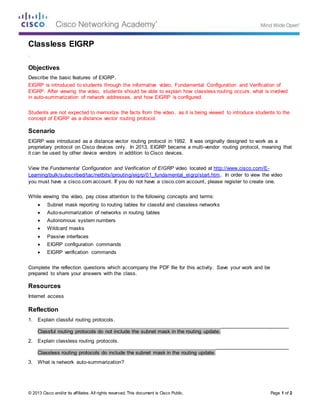More Related Content Similar to 7.0.1.2 classless eigrp instructions ig (20) 1. Classless EIGRP
.
Objectives
Describe the basic features of EIGRP.
EIGRP is introduced to students through the informative video, Fundamental Configuration and Verification of
EIGRP. After viewing the video, students should be able to explain how classless routing occurs, what is involved
in auto-summarization of network addresses, and how EIGRP is configured.
Students are not expected to memorize the facts from the video, as it is being viewed to introduce students to the
concept of EIGRP as a distance vector routing protocol.
Scenario
EIGRP was introduced as a distance vector routing protocol in 1992. It was originally designed to work as a
proprietary protocol on Cisco devices only. In 2013, EIGRP became a multi-vendor routing protocol, meaning that
it can be used by other device vendors in addition to Cisco devices.
View the Fundamental Configuration and Verification of EIGRP video located at http://www.cisco.com/E-Learning/
bulk/subscribed/tac/netbits/iprouting/eigrp/01_fundamental_eigrp/start.htm. In order to view the video
you must have a cisco.com account. If you do not have a cisco.com account, please register to create one.
While viewing the video, pay close attention to the following concepts and terms:
Subnet mask reporting to routing tables for classful and classless networks
Auto-summarization of networks in routing tables
Autonomous system numbers
Wildcard masks
Passive interfaces
EIGRP configuration commands
EIGRP verification commands
Complete the reflection questions which accompany the PDF file for this activity. Save your work and be
prepared to share your answers with the class.
Resources
Internet access
Reflection
1. Explain classful routing protocols.
_______________________________________________________________________________________
Classful routing protocols do not include the subnet mask in the routing update.
2. Explain classless routing protocols.
_______________________________________________________________________________________
Classless routing protocols do include the subnet mask in the routing update.
3. What is network auto-summarization?
© 2013 Cisco and/or its aff iliates. All rights reserved. This document is Cisco Public. Page 1 of 2
2. Classless EIGRP
__________________________________________________________________
Auto-summarization allows routing tables to be reduced in size by representing several subnetted networks
as one summarized network.
4. What is an autonomous system number?
__________________________________________________________________
An autonomous system number is used in EIGRP configuration to define all routers belonging to a specific
group to exchange EIGRP neighbor and update information.
5. What are wildcard masks?
__________________________________________________________________
Wildcard masks are the inverse of subnet masks. They indicate how many hosts are available within subnets
and are used as a part of the EIGRP configuration process to indicate specific, subnetted networks.
6. What is a passive interface?
__________________________________________________________________
A passive interface is a network link configured to not participate in the EIGRP reporting process.
7. Is EIGRP considered a distance-vector or a link-state routing protocol?
__________________________________________________________________
Like RIP, EIGRP is considered a distance vector routing protocol.
Identify elements of the model that map to IT-related content:
Auto-summarization
Classless routing
Wildcard masks
Passive interfaces
EIGRP routing protocol
Distance vector routing protocol
© 2013 Cisco and/or its aff iliates. All rights reserved. This document is Cisco Public. Page 2 of 2

